Health Articles
Pitta
Pitta people are generally quite well-balanced, well-proportioned, rounded, admired by all, but they can suddenly become passionately focused and intense. At its most extreme this tendency leads to a high degree of intolerance and irritability. Consequently pitta types should keep well away from any foods that are known to be hot and spicy, and which might inflame them, and concentrate on meals inflame them and concentrate on meals that promote their more soothing side.
Elements : fire and water.
Climate : hot and moist.
Principle : transformation. Em 0 t ion s: hate, anger, resen intolerance, impatience, irritability. indignation, jealousy, good humour, intelligence, alertness, open warm-heartedness.
Systems most affected by excess pitta : skin, metabolism. small intestines, eyes, liver, hair on
the head.
Symptoms of excess pitta: skin disorders, acidity, sun-sensitivity, premature degrees of hair loss or loss hair colour, outbreaks of diarrhoea.
The pitta body type is usually of average build and nicely proportioned. Pittas like food and have a healthy appetite. The hair is usually straight, fine and fai~ though dark-haired people can also be pitta types. People with red hair will automatically have some level of pitta within their nature. Like the fire element, their temperament can be quite intense, and when it manifests itself in excess this can lead to marked intolerance.
Pitta skin will have a tendency to be sensitive to the sun, and pitta types will need to be very careful how much time they spend in direct sunlight. The fiery nature of the sun will sometimes inflame the pitta person, leading to skin rashes, freckles and sunburn. Cool showers, cool environments and plenty of long cooling drinks (but not ice-cold ones) will help to alleviate any high temperatures and calm down pitta types.
People of this nature can be impatient, having highly active and alert minds. However pitta people can also have a very good sense of humour and a warm personality.
Click here to find more about Pitta People's Dietary Guide
http://www.byhealth.com/pitta-peoples-dietary-tips
Kapha People's Dietary Tips
Kapha people should focus upon cooked food, but can have some salads occasionally
They should avoid fats and oils unless they are hot and spicy Dairy products, sweet, sour and salty tastes and a high intake of wheat will also aggravate kapha.
Although some meats and animal products have been included, they should always be used in moderation.
To reduce any excess levels of kapha (vikruti), or to maintain the right balance because you are a kapha dosha (prakruti), include the following items in your eating plan and try to avoid any foods that are not listed here.
Herbs and Spices

Asafoetida (hing), black or Indian pepper; chilli pepper; coriander leaves (cilantro), dry ginger; garlic, horseradish, mint leaves, mustard, parsley or any other hot spices,
Grains and Seeds
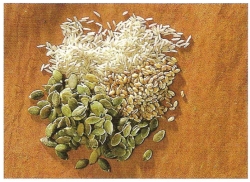
Barley, buckwheat, corn, couscous, oat bran, polenta, popcorn (plain), rye, sprouted
wheat bread, toasted pumpkin seeds and occasional small quantities of toasted sunflower seeds.
Beans and Pulses

Barley, buckwheat, corn, couscous, oat bran, polenta, popcorn (plain), rye, sprouted
wheat bread, toasted pumpkin seeds and occasional small quantities of toasted sunflower seeds.
Vegetables

Artichokes, broccoli, Brussels sprouts, cabbage, carrots, cauliflower; celery, daikon radish, fennel, green beans, kale, leeks,
lettuce, mushrooms, okra, onions, peas, peppers, radishes, spinach, Kapha vegetables should be cooked.
Fruits

Apples, apricots, berries, cherries,peaches, pears, pomegranates and prunes.
Cooking Oils
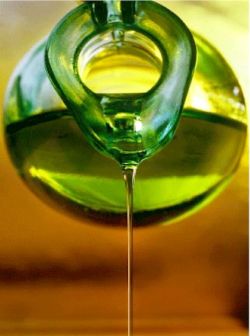
Corn, almond or sunflower oil may be used in small quantities.
Drinks

Fruit drinks should not contain sugar or additives. Recommended hot drinks include black tea, carrot juice, cranberry juice, grape juice, mango juice, mixed vegetable juice, nettle tea, passion flower tea, raspberry tea and occasional wine
Click Here for information about Vata People's Dietary Guide
http://www.byhealth.com/deitary-tips
Click Here for information about Pitta People's Dietary Guide
http://www.byhealth.com/dietary-tips
Common Remedies
It is quite clear that the forms taken by various commonly occurring illness and the appropriate remedies will vary according to wether you have vata, pitta or kapha dosha. The following sections therefore aim to give you individually a plan of action, setting out all the do’s and do not’s. Note that in the case of any persistent, or indeed serious illness, you must immediately contact a qualifies professional expert.
lnsomnia
Any vata-increasing influence can contribute to your insomnia, including regular travel, stress, an irregular lifestyle, and the excessive use of stimulants such as tea and coffee. The herbs used to treat vata-based insomnia are brahmi (Centella), jatamansi, ashwagandha (Withania somnifera) and nutmeg. Any good massage using brahmi oil will also produce considerable, quickly noticed benefits.
Insomnia in the pitta dosha is brought on by anger; jealousy, frustration, fever; excess sun or heat. Follow the pitta plan, which is cooling, and take brahmi, jatamansi, bhringaraj (Eclipta alba), shatavari and aloe vera juice. Massage brahmi oil into the head and feet. Again, this is marvellously refreshing.
As kapha types like to sleep and tend to be rather sleepy and sluggish, they rarely suffer from attacks of insomnia.
Headache/Migraine
Vata headaches cause extreme pain and are related to anxiety and tension. Relevant treatments include triphala to clear any congestion, jatamansi, brahmi and calamus.
Pitta headaches are associated with heat or burning sensations, flushed skin and a visual sensitivity to light. They are related to anger; frustration or irritability, and will be connected to the liver and gall bladder. Treatments are brahmi, turmeric and aloe vera juice. Kapha headaches are dulr and heavy and can cause nausea. There may also be congestion, such as catarrh. Have a stimulating massage with minimal oil
Colds
A tendency to mucus production or catarrh/phlegm is unpleasant for the sufferer; and is usually the result of poor digestion of foods in the stomach which increases ama (toxicity) and kapha. In general, kapha is generally considered the most highly effective dosha.
Vata-type colds involve dry symptoms, such as a dry cough or dry throat. Herbs for vata coughs and colds are ginger; cumin, pippali, tulsi (holy basil, Ocimum sanctum), cloves and peppermint, licorice (not to be used with high blood pressure or oedema), shatavari and ashwagandha. Put one or two drops of sesame oil up each nostril, and then follow the vata plan until all the symptoms are seen to subside.
Pitta-type colds involve more heat, the face is usually red and there may even be a fever. The mucus is often yellow and can actually contain traces of blood. Herbs for tackling pitta coughs and colds include peppermint and various other mints, sandalwood, chrysanthemum and small quantities of tulsi (holy basil).
Kapha colds are thick and mucusy with a feeling of heaviness in the head or body. Avoid cold, damp weather and exposure to cold and damp conditions. Eliminate sugar, refined foods, meat and nuts dairy products. Bread, fats and oils from the diet and use plenty of hot spices. Drink a spiced tea of hot lemon, ginger and cinnamon with cloves or tulsi, sweetened with a little raw honey. Herbs for kapha colds are ginger, cinnamon, pippali, tulsi (holy basil), cloves and peppermint. Saunas and hot baths will help to increase the heat of the kapha person but they should not be used in excess as this would actually increase the pitta too much. Follow the kapha plan until the symptoms subside.
Skin Problems
These are often caused by internal conditions taxicity (ama) and are mainly related to the pitta dosha. Vata skin problems will be dry and rough. Avoid letting the skin dry out. Herbal remedies for vata skin are triphala and satisabgol. Pitta skin problems will be red and swollen, often with a yellow head, Avoid sun heat or hot baths, and increase your intake of salads. Follow the pitta plan and add turmeric, coriander and saffron to your diet. The remedies are manjishta (Rubia cordifolia), kutki (Picrohiza kurroa), turmeric anc aloe vera juice. Kapha skin problems involve blood congesion which can cause the skin to form thick and mucusy whiteheads. Increase your level of exercise, and follow the kapha’s plan. Treatments should always include a small amount of calamus with some dry ginger and quantities of turmeric.
Urinary lnfections
Excess cold water, tea, coffee, and alcoholic drinks will weaken the kidneys, Salt, sugar or foods that are rich in calcium, such as dairy products or spinach, will similarly tend to weaken and toxify the kidneys. The best kidney tonic to use in Ayurveda is shilajit, a mineral-rich compound from the Himalayan mountains, but avoid it if you suffer from kidney stones. Pregnant women, children or those on medication should consult an Ayurvedic practitioner before treatment.
Coughs
Vata coughs are fry and irritated with very little mucus, the chief symptom being a painful cough often accompanied by adry mouth. Herbs and spices for the vata cough include licorice (do not use this if you have high blood pressure or oedema), shatavari, ashwagandha and cardamom. Follow the vata plan until the symptoms subside.
Pitta coughs are usually associated with a lot of phlegm. The chest is congested and very uncomfortable but the mucus cannot be brought up properly. There is often fever or heat combined with a burning sensation in the chest or throat. High fevers should be treated bya physician and people suffering with asthma should consult their doctor immediately if a cough or cold leads to wheezing and difficult breathing. The best herbs for pitta coughs include peppermint, tulsi (holy basil) and sandalwood. Follow the pitta plan until the symptoms have completely subsided.
With Kapha coughs the patient usually brings up lots of phlegm and suffers a loss of appetite combined with nausea. The chest is loaded with mucus, but this may not be coughed up because the kapha individual is likely to feel tired. Treatments for kapha coughs are raw honey, lemon, cloves and chyawanprash (a herbal jam). Follow the kapha plan until the symptoms subside, increasing your intake of hot spices and do try to use trikatu powder. Also Keep warm.
Cystitis
In vata people, cystitis will tend to be less intense. Remedies are shilajit (to be avoided if you suffer from kidney stones) with bala (Sida cordifolia), ashwagandha and shatavari,
Cystitis is mainly a pitta condition because it burns and is hot.
Follow the pitta plan, using plenty of coriander (cilantro) and avoiding hot spices. Remedies include aloe vera juice (not to be used in pregnancy), lime juice, coconut and sandalwood. Kaphatype cystitis is accompanied by congestion and mucus in the urinary tract. The treatments are cinnamon, trikatu combined with shilajit, gokshura and gokshurdi guggul.
Swine flu vaccines
September 25, 2009
The first five million swine flu vaccine dosages will be available to Australians next week but children under 10 will have to wait until at least October.
Experiments are underway at the Melbourne based manufacturer CSL to ensure the vaccine is safe in children.
The paediatric vaccine is supposed to be available sometime in October, after trials are completed and approved by the Therapeutic Goods Association.
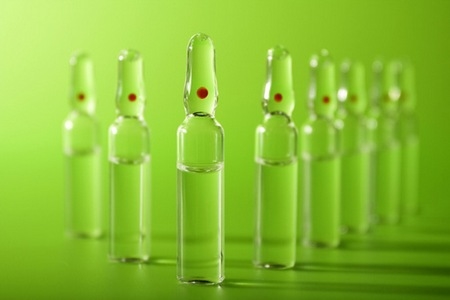
Federal Health Minister Nicola Roxon, who toured CSL's laboratories on Thursday, urged Australians to contact their GPs from September 30 to access the vaccine.
'We are urging all Australians particularly who are aged 10 and over to consider being vaccinated,' she told reporters.
'We expect to get 21 million doses of the vaccine provided by January next year,' she said.
The $100 million program to develop a swine flu vaccine in Australia has produced a vaccine which its maker says will have a 95 per cent success rate in adults.
Ms Roxon said the government's contractual arrangement with CSL had prioritised supplying Australia.
Although the vaccine comes at the end of the winter flu season in Australia, chief medical officer Jim Bishop said it would protect against the flu spreading from the northern hemisphere.
'The amount of doses that we have will be sufficient to protect the population against future waves of this virus,' he told reporters.
He said the northern hemisphere was now entering winter and there were already signs of increased infections in the United States and Europe.
'We'd expect that to seed back into this country,' he said.
Ms Roxon said people with asthma, diabetes, cancer, pregnant women and parents or carers of infants should consider accessing the vaccine from next week.
To date, 177 Australians and about 3,500 people worldwide with swine flu have died.
Prostate Cancer
About Prostate Cancer

Prostate cancer is a form of cancer that develops in the prostate, a gland in the male reproductive system. The cancer cells may metastasize (spread) from the prostate to other parts of the body, particularly the bones and lymph nodes. Prostate cancer may cause pain, difficulty in urinating, problems during sexual intercourse, or erectile dysfunction. Other symptoms can potentially develop during later stages of the disease.
Causes
The specific causes of prostate cancer remain unknown. A man's risk of developing prostate cancer is related to his age, genetics, race, diet, lifestyle, medications, and other factors.
The primary risk factor is age. Prostate cancer is uncommon in men younger than 45, but becomes more common with advancing age. The average age at the time of diagnosis is 70. However, many men never know they have prostate cancer. Autopsy studies of Chinese, German, Israeli, Jamaican, Swedish, and Ugandan men who died of other causes have found prostate cancer in thirty percent of men in their 50s, and in eighty percent of men in their 70s. In the year 2005 in the United States, there were an estimated 230,000 new cases of prostate cancer and 30,000 deaths due to prostate cancer.
What is Prostate?

The prostate is a part of the male reproductive organ that helps make and store seminal fluid. In adult men, a typical prostate is about three centimetres long and weighs about twenty grams. It is located in the pelvis, under the urinary bladder and in front of the rectum. The prostate surrounds part of the urethra, the tube that carries urine from the bladder during urination and semen during ejaculation. Because of its location, prostate diseases often affect urination, ejaculation, and rarely defecation. The prostate contains many small glands which make about twenty percent of the fluid constituting semen. In prostate cancer, the cells of these prostate glands mutate into cancer cells. The prostate glands require male hormones, known as androgens, to work properly. Androgens include testosterone, which is made in the testes; dehydroepiandrosterone, made in the adrenal glands and dihydrotestosterone, which is converted from testosterone within the prostate itself. Androgens are also responsible for secondary sex characteristics such as facial hair and increased muscle mass.
Symptoms
A man with prostate cancer may not have any symptoms. For men who do have symptoms, the common symptoms include:
Urinary problems
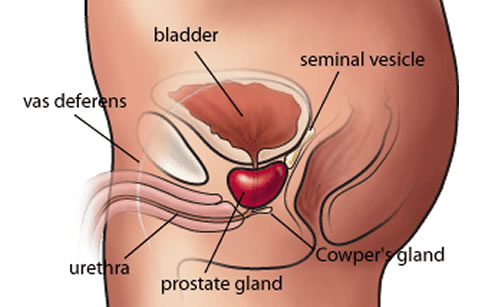
- Not being able to pass urine
- Having a hard time starting or stopping the urine flow
- Needing to urinate often, especially at night
- Weak flow of urine
- Urine flow that starts and stops
- Pain or burning during urination
Difficulty having an erection
- Blood in the urine or semen
- Frequent pain in the lower back, hips, or upper thighs
Most often, these symptoms are not due to cancer. BPH, an infection, or another health problem may cause them. If you have any of these symptoms, you should tell your doctor so that problems can be diagnosed and treated.
Predisposing Factors
Age
The main risk factor for prostate cancer is age. Prostate cancer is rarely diagnosed before the age of 40. After 40, the incidence rises rapidly. PSA testing is not generally carried out on men aged under 50 unless they have significant risk factors. The rates of prostate cancer at different ages are as follows:
|
Age |
Percentage of men |
|
20–30 |
2–8% |
|
31–40 |
9–31% |
|
41–50 |
3–43% |
|
51–60 |
5–46% |
|
61–70 |
14–70% |
|
71-80 |
31–83% |
|
81–90 |
40–73% |
Stages
When prostate cancer spreads, it's often found in nearby lymph nodes. If cancer has reached these nodes, it also may have spread to other lymph nodes, the bones, or other organs.
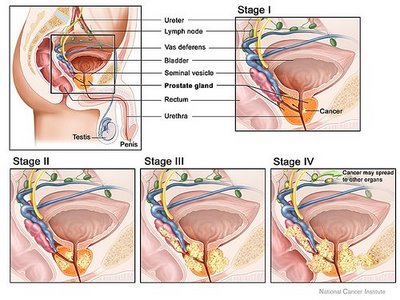
When cancer spreads from its original place to another part of the body, the new tumour has the same kind of abnormal cells and the same name as the primary tumour. For example, if prostate cancer spreads to bones, the cancer cells in the bones are actually prostate cancer cells. The disease is metastatic prostate cancer, not bone cancer. For that reason, it's treated as prostate cancer, not bone cancer. Doctors call the new tumour "distant" or metastatic disease.
These are the stages of prostate cancer:
Stage I: The cancer can't be felt during a digital rectal exam, and it can't be seen on a sonogram. It's found by chance when surgery is done for another reason, usually for BPH. The cancer is only in the prostate. The grade is G1, or the Gleason score is no higher than 4.
Stage II: The tumour is more advanced or a higher grade than Stage I, but the tumour doesn't extend beyond the prostate. It may be felt during a digital rectal exam, or it may be seen on a sonogram.
Stage III: The tumour extends beyond the prostate. The tumour may have invaded the seminal vesicles, but cancer cells haven't spread to the lymph nodes.
Stage IV: The tumour may have invaded the bladder, rectum, or nearby structures (beyond the seminal vesicles). It may have spread to the lymph nodes, bones, or to other parts of the body.
Treatments
There are different types of treatment for patients with prostate cancer.
Different types of treatment are available for patients with prostate cancer. 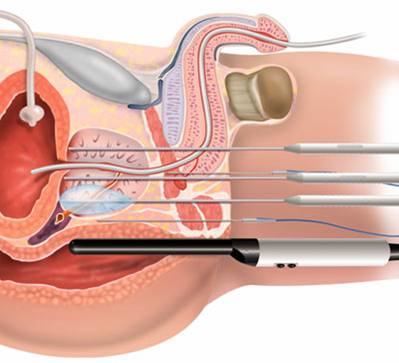 Some treatments are standard (the currently used treatment), and some are being tested in clinical trials. A treatment clinical trial is a research study meant to help improve current treatments or obtain information on new treatments for patients with cancer. When clinical trials show that a new treatment is better than the standard treatment, the new treatment may become the standard treatment. Patients may want to think about taking part in a clinical trial. Some clinical trials are open only to patients who have not started treatment.
Some treatments are standard (the currently used treatment), and some are being tested in clinical trials. A treatment clinical trial is a research study meant to help improve current treatments or obtain information on new treatments for patients with cancer. When clinical trials show that a new treatment is better than the standard treatment, the new treatment may become the standard treatment. Patients may want to think about taking part in a clinical trial. Some clinical trials are open only to patients who have not started treatment.
Four types of standard treatment are used:
Watchful waiting
Watchful waiting is closely monitoring a patient’s condition without giving any treatment until symptoms appear or change. This is usually used in older men with other medical problems and early- stage disease.
Surgery
Patients in good health are usually offered surgery as treatment for prostate cancer. The following types of surgery are used:
Pelvic lymphadenectomy: A surgical procedure to remove the lymph nodes in the pelvis. A pathologist views the tissue under a microscope to look for cancer cells. If the lymph nodes contain cancer, the doctor will not remove the prostate and may recommend other treatment.
Radical prostatectomy: A surgical procedure to remove the prostate, surrounding tissue, and seminal vesicles. There are 2 types of radical prostatectomy:
- Retro pubic prostatectomy: A surgical procedure to remove the prostate through an incision (cut) in the abdominal wall. Removal of nearby lymph nodes may be done at the same time.
- Perineal prostatectomy: A surgical procedure to remove the prostate through an incision (cut) made in the perineum (area between the scrotum and anus). Nearby lymph nodes may also be removed through a separate incision in the abdomen.
Transurethral Resection of the Prostate (TURP):
A surgical procedure to remove tissue from the prostate using a resectoscope (a thin, lighted tube with a cutting tool) inserted through the urethra. This procedure is sometimes done to relieve symptoms caused by a tumour before other cancer treatment is given. Transurethral resection of the prostate may also be done in men who cannot have a radical prostatectomy because of age or illness.
Impotence and leakage of urine from the bladder or stool from the rectum may occur in men treated with surgery. In some cases, doctors can use a technique known as nerve-sparing surgery. This type of surgery may save the nerves that control erection. However, men with large tumours or tumours that are very close to the nerves may not be able to have this surgery.
Radiation therapy
Radiation therapy is a cancer treatment that uses high-energy x-rays or other types of radiation to kill cancer cells or keep them from growing. There are two types of radiation therapy. External radiation therapy uses a machine outside the body to send radiation toward the cancer. Internal radiation therapy uses a radioactive substance sealed in needles, seeds, wires, or catheters that are placed directly into or near the cancer. The way the radiation therapy is given depends on the type and stage of the cancer being treated.
Impotence and urinary problems may occur in men treated with radiation therapy.
Hormone therapy
Hormone therapy is a cancer treatment that removes hormones or blocks their action and stops cancer cells from growing. Hormones are substances produced by glands in the body and circulated in the bloodstream. In prostate cancer, male sex hormones can cause prostate cancer to grow. Drugs, surgery, or other hormones are used to reduce the production of male hormones or block them from working.
Hormone therapy used in the treatment of prostate cancer may include the following:
- Luteinizing hormone-releasing hormone agonists can prevent the testicles from producing testosterone. Examples are leuprolide, goserelin, and buserelin.
- Antiandrogens can block the action of androgens (hormones that promote male sex characteristics). Two examples are flutamide and nilutamide.
- Drugs that can prevent the adrenal glands from making androgens include ketoconazole and aminoglutethimide.
- Orchiectomy is a surgical procedure to remove one or both testicles, the main source of male hormones, to decrease hormone production.
- Estrogens (hormones that promote female sex characteristics) can prevent the testicles from producing testosterone. However, estrogens are seldom used today in the treatment of prostate cancer because of the risk of serious side effects.

Hot flashes, impaired sexual function, loss of desire for sex, and weakened bones may occur in men treated with hormone therapy.
New types of treatment are being tested in clinical trials.
Cryosurgery
Cryosurgery is a treatment that uses an instrument to freeze and destroy prostate cancer cells. This type of treatment is also called cryotherapy.
Impotence and leakage of urine from the bladder or stool from the rectum may occur in men treated with cryosurgery.
Chemotherapy
Chemotherapy is a cancer treatment that uses drugs to stop the growth of cancer cells, either by killing the cells or by stopping them from dividing. When chemotherapy is taken by mouth or injected into a vein or muscle, the drugs enter the bloodstream and can reach cancer cells throughout the body (systemic chemotherapy). When chemotherapy is placed directly into the spinal column, an organ, or a body cavity such as the abdomen, the drugs mainly affect cancer cells in those areas (regional chemotherapy). The way the chemotherapy is given depends on the type and stage of the cancer being treated.
Biologic therapy
Biologic therapy is a treatment that uses the patient’s immune system to fight cancer. Substances made by the body or made in a laboratory are used to boost, direct, or restore the body’s natural defences against cancer. This type of cancer treatment is also called biotherapy or immunotherapy.
High-intensity focused ultrasound
High-intensity focused ultrasound is a treatment that uses ultrasound (high-energy sound waves) to destroy cancer cells. To treat prostate cancer, an endorectal probe is used to make the sound waves.
The review of this section illustrates the treatment that is being studied in clinical trials. It may not mention every new treatment being studied.
Patients may want to think about taking part in a clinical trial.
For some patients, taking part in a clinical trial may be the best treatment choice. Clinical trials are part of the cancer research process. Clinical trials are done to find out if new cancer treatments are safe and effective or better than the standard treatment.
Many of today's standard treatments for cancer are based on earlier clinical trials. Patients who take part in a clinical trial may receive the standard treatment or be among the first to receive a new treatment.
Patients who take part in clinical trials also help improve the way cancer will be treated in the future. Even when clinical trials do not lead to effective new treatments, they often answer important questions and help move research forward.
Patients can enter clinical trials before, during, or after starting their cancer treatment.
Some clinical trials only include patients who have not yet received treatment. Other trials test treatments for patients whose cancer has not gotten better. There are also clinical trials that test new ways to stop cancer from recurring (coming back) or reduce the side effects of cancer treatment.
Follow-up tests may be needed.
Some of the tests that were done to diagnose the cancer or to find out the stage of the cancer may be repeated. Some tests will be repeated in order to see how well the treatment is working. Decisions about whether to continue change, or stop treatment may be based on the results of these tests. This is sometimes called re-staging.
Skin - Integumentary System
The integumentary system (integument, a covering) consists of the skin (cutis) and its appendages. The protective covering for the body known as the skin is one of the largest organs of the body and accounts for approximately 16% of the body weight. It contains glands, blood vessels, lymphatic vessels, nerves, and smooth muscle (arrector pili muscles). The appendages are derived from the overlying epidermis and include two types of sweat glands, sebaceous glands, hair, and nails.
The skin has two defining tissue types, epidermis (keratinocytes are derived from ectoderm) and dermis (derived from mesoderm). The dermis interfaces with the underlying hypodermis, which is the fatty subcutaneous connective tissue or the superficial fascia of gross anatomy. Although the hypodermis not officially considered to be one of the layers of the skin, it is a loose connective tissues that attaches the skin to underlying tissues by way of vertical septae and permits skin mobility over most parts of the body (e.g., when it is pinched up), it serves as an insulator and shock absorber and serves as a caloric reservoir.
Skin is often classified as either thick skin or thin skin. This classification refers to epidermal thickness rather than dermal thickness or to the thickness of the skin as a whole. Thick skin (= thick epidermis) is restricted to palms and soles. Thin skin (= thin epidermis) covers the remainder of the body. Although skin may have a very thick dermis in some sites, as on the back, it is classified as thin skin if the epidermis is thin.
Skin has many functions, some of which can be appreciated from the study of its microscopic structure. As the covering of the body, the skin provides some protection from injury, and from the entry of microorganisms. Protection is also provided by the melanocytes, which produce pigment to shield the body from too much ultraviolet light. The skin functions in temperature regulation, e.g., by sweating, varying peripheral blood flow. It covers the surface with sebum to lubricate the epidermal surface and prevent cracking. The adipose tissue of the hypodermis provides insulation. The skin also functions in excretion (and secretion) via its sweat and sebaceous glands. Moreover, it stores fat, manufactures vitamin D and is the first guard of the immunosurveillance system. Cutaneous receptors for touch, pressure, heat, and pain stimuli provide a sensory appreciation of the environment; thus the skin serves as a sensory organ. The skin acts as a friction surface for motor tasks involving grasping, rubbing, scratching, etc. The skin is also important in preventing the loss of body fluids, a fact that is well illustrated when excessive fluid loss occurs after extensive burns.
Thick Epidermis/Thick Skin
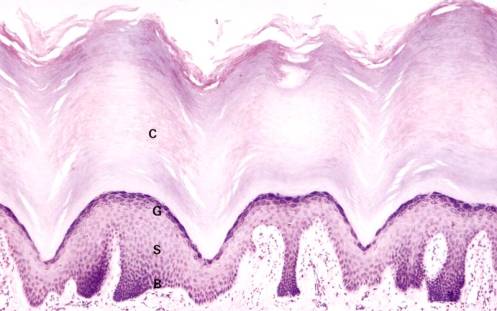
The predominant cell type, an epidermal keratinocyte begins its life cycle in the basal layer and becomes progressively more differentiated as it moves toward the surface - a process that produces a stratified squamous keratinizing epithelium.
Observe the flattened, dead surface cells (sometimes called corneocytes or dandruff in the scalp) of the thick stratum corneum. A few of the surface cells are being desquamated. Some areas of the stratum corneum show spiraling sweat ducts, each of which will end in a sweat pore at the surface. Nuclei and other cellular organelles are absent in the stratum corneum.
The stratum granulosum is composed of increasingly flattened rectangular-shaped cells filled with keratohyalin granules. The large accumulation of basophilic granules in these cells is composed of filaggrin and keratin filaments. The thickness of this layer varies from one to three cells and as a rule is representative of the rate of keratinization. Thus, there are little or no stratum granulosum or keratohyalin granules in diseases, with a rapid rate of keratinization such as psoriasis, whereas the granular layer is thickened in diseases with a slow rate of keratinization.
The stratum spinosum is composed of several layers of polyhedral cells, which flatten as the stratum granulosum is approached. See Figure left. The cytoplasm is rich in tonofibrils, which are specific for keratin pairs 1 and 10. Individual cells appear to be separated by spaces that are traversed by the so-called intercellular bridges which, under oil immersion, can be seen as fine lines between adjacent cells. 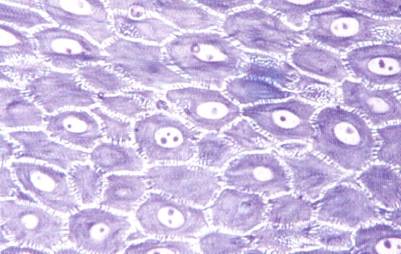
They account for the prickly appearance of the cells and for their frequent designation as prickle cells. These are tissue preparation artifacts caused when water is removed during the dehydration step. Spinous cells are attached to their neighbors by a multitude of desmosomal attachments and these connections remain as the fragile cytoplasm shrinks.
The stratum basalis is composed of a single layer of cuboidal to columnar cells, which are attached to the basement membrane by hemidesmosomes. These cells express keratin intermediate filament pairs 5 and 14. This layer contains the stem cell population and an occasional mitotic figure of a transient amplifying cell may be observed. A few melanocytes (1 for every 36 keratinocytes) can be identified by their pale (empty) cytoplasm and dark nuclei among the keratinocytes of the stratum basalis. These cells do not contain tough keratin filaments and also shrink during tissue preparation.
A basement membrane exists between the epidermis and dermis. Reticular fibers are present in the basement membrane and account for the prominence of this structure after PAS staining. Note that the border between the epidermis and dermis known as the dermal-epidermal junction is irregular because numerous upward interdigitations known as dermal papillae indent the undersurface of the epidermis. Papillae are far more prominent in thick skin than in thin skin since they serve to help these surfaces resist shear forces and friction. Rete pegs are corresponding elongated downward projecting ridges of epidermis. Some rete pegs are narrower than others are and they are the ones, which receive the sweat ducts. Under oil immersion, note that the basal cells of the larger pegs have very fine processes, which anchor the cells to the basement membrane. Basal cells of the narrow ridges are smoother, allowing them to shift more easily.
Numerous capillaries are present in the papillae of the papillary layer. Meissner's corpuscles (encapsulated sensory nerve endings for touch that resemble sectioned pinecones) can be seen in some papillae (see Figure below). The reticular layer of the dermis is so named because of the woven arrangement of the heavily cross-linked collagenous fibers (in the form of a close meshed net) and not because of the presence of reticular fibers. Note that the collagenous fibers, although cut in transverse, oblique, and longitudinal planes, run parallel and not vertical to the epidermis.
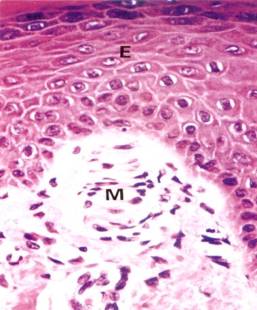
Secretory portions of eccrine sweat glands can be seen deep in the reticular dermis and extending deeper into the upper hypodermis. In addition to the secretory portions of sweat glands, the hypodermis (subcutaneous connective tissue) contains lobules of adipose tissue, which are separated by strands of collagenous fibers. When these septae become excessively filled with well-nourished adipocytes, the surface of the skin becomes dimpled and the appearance is known as cellulite.
Thin skin
The epidermis of thin skin has far fewer cells in each of its layers (i.e., the total thickness of the stratum corneum, stratum granulosum, and stratum spinosum are greatly reduced in thickness). Identify the melanocytes with dark nuclei and pale cytoplasm that can be seen interspersed between the keratinocytes in the stratum basale. Note that the brown melanin pigment that is present is confined to the keratinocytes in either the basal epidermis or those in the hair bulb. A few pigment containing macrophages can occasionally be seen in the dermis. These cells are phagocytic and do not produce pigment. Note that the dermal papillae and rete pegs are less developed than in thick skin thus the waviness of the dermal-epidermal junction is not as pronounced. The dermis is comparable to that of thick skin in that it has a thinner, more superficial papillary layer and a thicker, more deeply situated reticular layer.
The small blood vessels of the subpapillary plexus are located at the junction of the reticular layer and the papillary layer. Vessels arising from this plexus can be seen as capillaries and arterioles in the dermal papillae. The papillary blood vessels are in close association with the epidermal cells, which require nourishment for their growth and development.
Melanin, the pigment largely responsible for skin color, is produced by melanocytes, which number about the same in all races but differ in the amount of melanin they produce. Melanin is transferred via long cytoplasmic processes of melanocytes to the intercellular spaces where it is taken up by keratinocytes and placed in a supranuclear position melanosomes. Cell bodies and cytoplasmic processes of melanocytes are not clearly shown by conventional stains, but they can be demonstrated by treatment of sections with dihydroxyphenylalanine (DOPA). The DOPA reaction demonstrates that the cell bodies of most melanocytes are located in the stratum basale while their cytoplasmic processes (some times called dendritic processes) extend between cells of the stratum spinosum. Cells from the melanocytic lineage can also be identified by immunostaining using an S-100 antisera.
Epidermal Appendages/Adnexal Structures
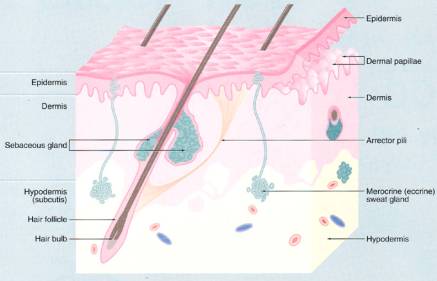
The small, cuboidal cells -bordering the basement membrane undergo mitosis to replenish the more central ones which accumulate lipid and are lost as the glandular secretion. As a cell accumulates fat droplets, it enlarges to become polyhedral or spherical in shape. The nucleus becomes pyknotic and the entire cell eventually disintegrates to enter the sebaceous gland duct as sebum. This mode of secretion in which the entire cell is lost is called holocrine secretion, and is characteristic of sebaceous glands. Find a duct, which connects with the alveoli of a sebaceous gland. Ducts are lined with stratified squamous epithelium and open into hair follicles. Sebaceous glands in some locations (e.g., those in the margins of the lips, nipple, and glans and prepuce of penis) do not connect with hair follicles, but directly onto the surface of the skin.
There are two classes of sweat glands (sudoriparous glands), merocrine and apocrine. Most sweat glands of the body are of the merocrine type and are usually referred to as eccrine sweat glands. They are most numerous in the skin of the palms, soles, and forehead. It has been estimated that they number about 3000 per square inch in the palm of the hand. They are called merocrine glands because they secrete by the merocrine method, i.e., no part of the cell is lost with the secretion. Secretion leaves the cells in a manner that might be described as reverse pinocytosis. Apocrine sweat glands are encountered in only a few areas, e.g., in the axillae and in the anogenital region. They are called apocrine glands because they secrete by the apocrine method, i.e., the apical portion of the cell breaks off to form part of the secretion. Both types of sweat glands are simple coiled tubular glands. This means that each sweat gland has its own duct (one duct per gland) and that the secretory portion of the gland is a small-coiled tube.
Secretory portions of the glands lie deep in the dermis, at the dermal-hypodermal junction, or occasionally within the hypodermis. A section through the secretory portion of a sweat gland will cut the coiled tubule into several cross sections (see Figure left photo). It may appear that two layers of secretory cells line a tubule, but the outermost cells with somewhat elongated nuclei are the myoepithelial cells, which occupy a constant position between the basement membrane and the base of the secretory cells (see Figure right photo). Myoepithelial cells have long contractile processes, which embrace the secretory cells and squeeze out the secretion. The processes are not visible in H&E preparation, but they can be demonstrated by the alkaline phosphatase technique. Myoepithelial cells are also present in other glands, salivary glands, and mammary glands, and in each instance they occupy a similar position between the basement membrane and the base of the glandular epithelial cell. In addition to basally located myoepithelial cells, pale cuboidal secretory cells can be seen surrounding the lumen of the secretory tubule.
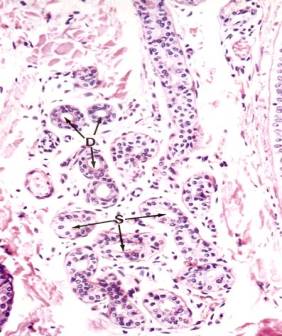
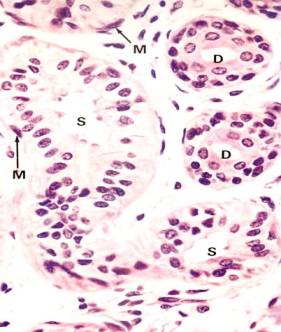
Intradermal sweat ducts are lined by two layers of cells whose cytoplasm is darker than that of secretory cells. The two-layered epithelium of the sweat duct is classified as stratified cuboidal. Myoepithelial cells are absent in the duct.
Secretory portions of apocrine glands are much larger than secretory portions of eccrine glands and their lumina measure as much as 200 μm in diameter (see Figure 61 below). This is ten times the average diameter of lumina of eccrine sweat glands. Apices of some cells of apocrine glands are rounded and can be seen breaking off to enter the lumina as part of the secretion. This mode of secretion where part of the cell is lost is termed apocrine secretion. Myoepithelial cells are present in secretory portions of apocrine glands, and appear even more prominent than in eccrine glands.
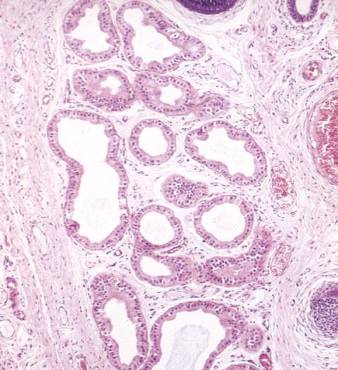 Micrograph of apocrine sweat glands.
Micrograph of apocrine sweat glands.
The intradermal ducts of apocrine glands have the same histological appearance as corresponding ducts of eccrine glands. They are devoid of myoepithelium and have a double layer of dark staining epithelial cells, which have a periluminal cuticle. The latter becomes especially prominent as the duct traverses the papillary layer of the dermis. Most ducts of apocrine glands open into hair follicles, but some open directly onto the surface, as do all eccrine ducts. Quite commonly, more than one apocrine duct empties into the same hair follicle, usually entering the follicle slightly above the opening of the sebaceous duct.
Apocrine and eccrine glands have other differences in addition to those of histological importance. Eccrine glands are supplied with cholinergic fibers while apocrine glands are supplied with adrenergic fibers. Eccrine glands serve primarily in heat regulation whereas apocrine glands represent scent glands similar to those producing pheromones in lower animals. Both types of glands are stimulated to secrete by stresses such as fright and pain, but eccrine glands also respond to heat while apocrine glands do not. In contrast to eccrine glands, apocrine glands are greatly influenced by hormones, becoming active about the time of puberty and showing secretory variation during the menstrual cycle.
Hair Follicles/Nails
Keratinocytes that form these appendages grow downward from the surface during the 3-4 month of development. The stem cell population resides in the bulge region where the erector pili muscle inserts into the hair shaft. Periodically these cells grow downward (anagen growth phase), form an expanded hair bulb in the deep dermis or hypodermis and begin to undergo a special pattern of differentiation that will produce a highly keratinized structure known as hair. The transiently amplifying hair matrix cells are found at the upper indentation of the hair bulb above of a tuft of capillaries, the dermal hair papilla that provide nourishment. Melanocytes also populate the hair bulb region and provide coloration to the hair. The cells lining the outer surface of the length of the hair follicle are known as outer root sheath cells and the multiple inner cell layers are known as inner root sheath cells.
Hairs (terminally differentiated cells that are equivalent to dead stratum corneum squames on the surface) move upward where they become coated with sebum (oil) and eventually erupt at the epidermal surface. Hair (totally dead cells) has an outer cuticle and an inner cortex. Periodically the hair bulb begins to regress upward to the bulge region (catagen phase), the hair is shed at the surface, and the hair follicle enters the telogen (resting) phase. The length of the hair growth cycle and the type of hair (terminal hair on the head, vellus-fine hair, pubic hair) is determined by local signals as well as hormones.
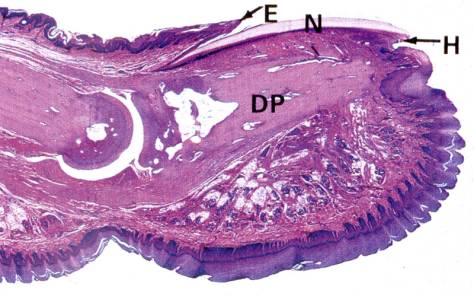 Micrograph of a developing fingernail on the distal phalanx (DP). E = eponychium, N = Nail, H = hyponychium.
Micrograph of a developing fingernail on the distal phalanx (DP). E = eponychium, N = Nail, H = hyponychium.
Fingernails and toe nails represent yet another type of differentiation (see Figure). The nail matrix cells are located under the skin fold at the proximal region of the distal phalanx. Destruction of nail matrix cells will result in a permanent nail loss. The more differentiated cells advance toward the fingertip. The newly differentiated cells form a crescent-shaped lunula (white region that is grossly visible). The proximal dead skin that is carried forward by continuous nail growth is known as the eponychium and the fold of skin underneath the distal growing tip is called the hyponychium. The dead nail advances across epidermal cells called the nail bed.
13 Day Royal Danish Hospital Diet - Best Diet to loose weight up to 13 - 22 pounds in 13 days
This diet lasts 13 days and although difficult, it is efficient. The metabolism's change is that fundamental that at the end of the diet one can come back to the normal alimentation without gaining weight for two years. If the diet is respected daily, step by step, one can lose all the fat accumulated in tissues. The diet must last exactly 13 days, not more and not less.
Recommendations:
Any aliment added beside the aliments allowed by the diet (a candy, a chewing gum, a biscuit, a glass of beer or wine) imposes the immediate stop of the diet as it has no longer effect. You can start over again only in six months. In case you cannot resist to keep the diet more than 6 days (respecting all the alimentary indications), stop it and begin again the diet after three months.
If you are hungry, drink water, at least 2 l/day.
The lettuce should be fresh.
The code (the fish) can be replaced by trout or plaice.
Coffee cannot be replaced by tea or the other way round.
The natural yogurt is the non- pasteurized one, without sweeteners or fruits addition.
DAY 1:
Breakfast: 1 cup of coffee + 1 cube of sugar
Lunch: 2 hard-boiled eggs + 400 g spinach + 1 tomato
Dinner: 200 g roast beef + 1 lettuce with oil and lemon juice
DAY 2:
Breakfast: 1 cup of coffee + 1 cube of sugar
Lunch: 250 g ham + 1 can of natural yogurt
Dinner: 200 g roast beef + 1 lettuce with oil and lemon juice
DAY 3:
Breakfast: 1 cup of coffee + 1 cube of sugar + 1 slice of toast
Lunch: 2 hard-boiled eggs + 1 slice of ham + 1 lettuce
Dinner: boiled celery + 1 tomato+ 1 fresh fruit (apple, pear, orange)
DAY 4:
Breakfast: 1 cup of coffee + 1 cube of sugar + 1 slice of toast
Lunch: 200 ml orange juice + 1 can of natural yogurt
Dinner: 1 hard-boiled egg + 1 rubbed out carrot + 250 g cow cheese
DAY 5:
Breakfast: 1 big rubbed out carrot
Lunch: 200 g steamed code with lemon juice + 1 spoon with butter
Dinner: 200 g roast beef + 1 rubbed out celery
DAY 6:
Breakfast: 1 cup of coffee + 1 cube of sugar + 1 slice of toast
Lunch: 2 hard-boiled eggs + 1 big rubbed out carrot
Dinner: 1/2 chicken + 1 lettuce with oil and lemon juice
DAY 7:
Breakfast: 1 cup of unsweetened tea
Lunch: nothing (drink lot of water, it helps!)
Dinner: 200 g lamb steak + 1 apple
DAY 8:
Breakfast: 1 cup of coffee + 1 cube of sugar
Lunch: 2 hard-boiled eggs + 400 g spinach + 1 tomato
Dinner: 200 g roast beef + 1 lettuce with oil and lemon juice
DAY 9:
Breakfast: 1 cup of coffee + 1 cube of sugar
Lunch: 250 g ham + 1 can of natural yogurt
Dinner: 250 g roast beef + 1 salad with oil and lemon juice
DAY 10:
Breakfast: 1 cup of coffee + 1 cube of sugar + 1 slice of toast
Lunch: 2 hard-boiled eggs+ 1 slice of ham + 1 lettuce
Dinner: 1 boiled celery + 1 tomato + 1 fresh fruit (apple, pear, orange)
DAY 11:
Breakfast: 1 cup of coffee + 1 cube of sugar + 1 slice of toast
Lunch: 200 ml orange juice + 1 can of natural yogurt
Dinner: 1 hard-boiled egg + 1 rubbed out carrot+ 250 g cow cheese
DAY 12:
Breakfast: 1 big carrot
Lunch: 200 g steamed code with lemon juice + 1 spoon with butter
Dinner: 250 g roast beef + 1 rubbed out celery
DAY 13:
Breakfast: cup of coffee + 1 cube of sugar + 1 slice of toast
Lunch: 2 hard-boiled eggs+ 1 big rubbed out carrot
Dinner: 250 g chicken + 1 lettuce with oil and lemon juice
Emotions and illness
Emotions are considered a form of energy that play an integral role in the development of health or illness.
TCM has traditionally viewed the emotions are one of the primary cause of disease. this is in direct contrast to the reductionist viewpoint of western medicine, which has fragmented the human being and separated the psyche from the physical body
Western Medicine has traditionally viewed the emotions as the secondary factors to the cause of disease.
A person suffering from ulcers sees a gastroenterologist and receives medication for his pain, but the stress that may be the cause of his problem is not addressed.

In contrast, Oriental medicine recognizes the innate connection between the mind, body and the emotions.
Emotions are not only a source of disease but can also be a result of illness
Traditional Chinese medicine acknowledges seven emotions. Each of the major organs is affected by and connected with a particular emotion that affects the life energy in a particular way.
The seven emotions are:
Anger - which affects the Liver
Melancholy - which affects the Lungs
Joy or Overexcitement - which affects the Kidneys
Worry and Excessive Thinking - which affects the Spleen and the Lungs
Shock - which affects the Kidneys and the Heart
It is important to note that, under normal conditions, emotions are not a cause of disease. Since energy is inherently neutral, the emotional energies that can be misdirected toward illness can also be harnesses for positive growth and development.
Each emotion has the positive side, an aspect that can be utilized for making a productive and wholesome emotional life, For example the Yang (positive) energy of the Liver, with its tendency to rise, is a very powerful energy that, when brought under control and directed, can be used for making positive decisions and changes in one's life. The liver partner is a Gall Bladder, which gives courage to the decision-making process and works in concert with the Heart and Small Intestine. This courage comes from the positive directing of the Liver's energies, which are supposed to be free flowing and smooth.
The same energy that produces Worry and Excessive Thinking, which affect the Spleen, can be transformed into a powerful capacity for memory and the ability to concentrate and contemplate.
The positive complement of Fear is willpower and the ability not only to have a strong memory but to be resolute and determined, focused and energetic in the accomplishing of one's goals.
The energies of the lungs can be used for strengthening breathing, which in turn helps to calm the mind.
The relationship between breathing exercises and meditation was recognized long ago by the Taoist monks of China as well as by Buddhists and practitioners of other esoteric philosophies.
By focusing on breathing the mind is quieted, allowing the individual to reach higher levels of consciousness within himself.
The best way of relating to one's emotions is not through disregarding them or repressing them but by acknowledging and facing them, and redirecting those energies for internal growth and development.
Energy balancing therapies such as acupuncture can result in dramatic changes in emotional states, but serious emotional work is also necessary for real, permanent change.
Many extreme disease conditions including cancer have been linked to general emotional states.
Omega 3
• Omega 3 is the name of a type of fat that is found in oil-rich fish and some plant oils and is also known as ‘n-3‘.
• Omega‐3 and omega‐6 fats are both polyunsaturated fatty acids.
• The main forms of omega‐3 are the “parent” molecule, Alpha Linolenic Acid (ALA), which can be found in a variety of plant based sources such as walnut, hemp, soy, flax and canola oil and the two longer‐chain omega‐3 molecules, docosahexaenoic acid (DHA) and eicosapentaenoic acid (EPA).
• DHA and EPA are “essential” fatty acids, which means that our bodies can’t
synthesise them and we need to consume them in our foods such as fish, nut and plant-based oils, such as canola oil and sunflower oils.

• A small percentage of the ALA consumed can be converted into DHA and EPA in our bodies but the richest source of these essential fatty acids is seafood.
Long-chain omega 3 fatty acids are needed for normal growth and development in the body, and are also required to maintain cardiovascular health and brain function. Therefore, everybody should be aiming to consume enough regularly to prevent deficiencies and to be healthy.
Since omega 3 essential fatty acids are needed for the membranes of all body cells their role in health is wide reaching: encompassing not only healthy heart and brain function but also playing an important role in the normal function of the eyes, the nervous system, the kidney, and the liver, in fact all body systems. Other functions also include the contraction of muscles and the dilation/constriction of blood vessels, blood clotting, and inflammatory processes.
Only consuming plant sources of essential fatty acids (i.e. ALA) means that the conversion process to the longer chain fats, DHA and EPA, will not be efficient therefore possibly requiring an additional source of omega 3 to maintain optimum intakes.
The main oil-rich fish available are: salmon, trout, mackerel, sardines, pilchards, herring, kipper, eel and whitebait, fresh, frozen or tinned. Tuna is only counted as an oily fish if it is fresh or frozen, as the tinned variety does have some oils, but not as much as the fresh one.
What are the types of omega-3 fatty acids?
ALA – ALA, or alpha-linolenic acid, is an 18-carbon chain and three cis double bonds. The first double bond is located in the n-3 position or at the omega end of the fatty acid. Thus, ALA is considered a polyunsaturated n-3 (omega-3) fatty acid.
EPA – EPA or eicosapentaenoic acid contains a 20-carbon chain and five cis double bonds; the first double bond is located at the third carbon from the omega end. Therefore, EPA also is considered an omega-3 fatty acid.
DHA – DHA or docosahexaenoic acid is a 22-carbon chain with six cis double bonds; the first double bond is located at the third carbon from the omega end of the fatty acid. Therefore, DHA is also considered an omega-3 fatty acid.
What are the sources of these omega-3 fatty acids?
ALA – Flaxseed, canola and soybean oils, and walnuts
EPA and DHA – Fatty fishes such as mackerel, herring, salmon, tuna, and trout
Omega 3 Health Benefits
- Builds better brain functioning. Pregnant and nursing mothers can have a great impact on the intelligence and happiness of their babies by supplementing with fish oil. For adults, omega 3 improves memory, recall, reasoning and focus. You'll swear you're getting younger and smarter.
- Decreases pain and inflammation. Omega 3 fatty acids, particularly EPA, have a very positive effect on your inflammatory response. Through several mechanisms, they regulate your body's inflammation cycle, which prevents and relieves painful conditions like arthritis, allergy rhinitis, prostatitis, cystitis and anything else with an "itis" ending.
- Improves cardiovascular health. Omega 3 fatty acids have also been proven to work wonders for your heart and the miles and miles of arteries and veins that make up your cardiovascular system. They help lower cholesterol, triglycerides, bad LDLs and blood pressure, while at the same time increasing good HDL cholesterol. This adds years to your life expectancy. Omega 3 with EPA and DPA is your best defence.
- Reduces heart attack and strokes. When plaque builds up on arterial walls and then breaks loose, it causes a thrombosis, which is a fancy way of saying blood clot. If a clot gets stuck in the brain, it causes a stroke and when it plugs an artery, it causes a heart attack. Research shows omega 3 fatty acids break up clots before they can cause any damage.
- Reduces depression and psychosis. Making you smarter is not all omega-3 does for your brain. Psychiatry department researchers at the University of Sheffield, along with many other research studies, found that omega 3 fish oil supplements "alleviate" the symptoms of depression, bipolar and psychosis
- Increases both male and female fertility. Studies show that infertility is directly related to the amount of fish oil you consume. Fish oil balances hormones, improves hormonal levels and increases blood flow to the uterus. The more Omega 3 fatty acids you get the greater your odds of conceiving.
- Improves all around pregnancy health. Omega 3 fish oil has been shown to reduce the danger of pregnancy preeclampsia (high blood pressure), premature birth and postpartum depression. Fish oil fatty acids also facilitate a healthy placental blood flow and the efficient exchange of nutrients and oxygen between mother and baby and greatly contributes to proper brain development, increasing the child's intelligence.
- Lowers incidence of childhood disorders. Just to show how fish oil fatty acids leave nobody out, studies show that children (and adults) with ADD and ADHD experience a greatly improved quality of life. And those with dyslexia, dyspraxia and compulsive disorders have gotten a new lease on life thanks to omega 3 oils.
- Decreases chances of osteoporosis. Having high levels of fish oil fatty acids has been shown to lower the risk of osteoporosis, which is an especially high for women after menopause.
- Reduces Breast, Colon and Prostate Cancer. And finally, omega 3 fish oil has been shown to help prevent three of the most common forms of cancer - breast, colon and prostate. Science tells us that omega 3s accomplish these in three ways. They stop the alteration from a normal healthy cell to a cancerous mass, inhibiting unwanted cellular growth and causing apoptosis, or cellular death, of cancer cells.

Omega 3 Foods
• Grains
• Spirulina
• Brazil Nuts
• Hempseed Oil
• Mustard Seeds
• Pumpkin Seeds
• Chia Seed Oil
• Wheat Germ Oil
• Canola Oil (Rapeseed)
• Green Leafy Vegetables
• Raw Walnuts & Walnut Oil
• Flaxseeds or Flaxseed Oil
Fish oil
What is Fish oil
Fish oil is derived from the tissues of oily fish and is a source of omega-3 (EPA) Eicosapentaenoic acid and (DHA) Docosahexaenoic acid essential fatty acids. These fats are considered 'essential' because they cannot be synthesised by the body and must be supplied through the diet or via supplementation.
What is the difference between omega-3 and fish oil?
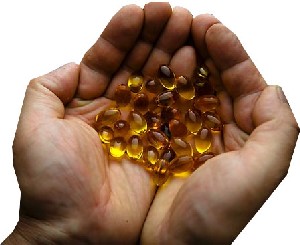 Omega-3 is a component of fish oil. The omega-3 fatty acids found in fish oil are Eicosapentaenoic Acid (EPA) and Docosahexaenoic Acid (DHA). It is the EPA+DHA content of fish oil which provide many of its therapeutic benefits. While omega-3 can be found in foods such as linseeds and wheat-germ, combined omega-3 fatty acids eicosapentaenoic acid and docosahexaenoic acid are available in large amounts in deep-sea cold water oily fish such as salmon, anchovies, mackerel and sardines.
Omega-3 is a component of fish oil. The omega-3 fatty acids found in fish oil are Eicosapentaenoic Acid (EPA) and Docosahexaenoic Acid (DHA). It is the EPA+DHA content of fish oil which provide many of its therapeutic benefits. While omega-3 can be found in foods such as linseeds and wheat-germ, combined omega-3 fatty acids eicosapentaenoic acid and docosahexaenoic acid are available in large amounts in deep-sea cold water oily fish such as salmon, anchovies, mackerel and sardines.
Grams of omega-3 fatty acids per 3oz (85g) serving of popular fish
| Tuna (canned, light) | 0.17-0.24 |
| Tuna | 0.21–1.1 |
| Tilefish | 0.90 |
| Swordfish | 0.97 |
| Shark | 0.83 |
| Salmon | 1.1–1.9 |
| Red snapper | 0.29 |
| Pollock | 0.45 |
| Orange roughy | 0.028 |
| Mahi mahi | 0.13 |
| King mackerel | 0.36 |
| Halibut | 0.60–1.12 |
| Grouper | 0.23 |
| Flounder | 0.48 |
| Cod | 0.15–0.24 |
| Catfish | 0.22–0.3 |
Types of Omega fatty Acids
1. Omega-3 fatty acids are found in both plant and animals but the most concentrated dietary source of combined omega-3s EPA and DHA is fish oil from cold-water fish, such as salmon, tuna, sardines and mackerel.
2. Omega-6 fatty acids obtained from the diet such as linoleic acid (LA) and gamma-linoleic acid (GLA) come from vegetable oils.Omega-6 fatty acids are important for the health of our cell membranes, and may be recommended for conditions of the skin including dry skin and eczema.
3. Omega-9 fats are a class of mono-unsaturated fats and are found in vegetable oils such as olive oil.
Health Benefits of Fish Oil
• Prevent sudden cardiac death (50% risk reduction).
• Prevent stroke (40-50% risk reduction).
• Prevent irregular heartbeat.
• Prevent some forms of cancer (e.g. Breast Cancer & Colon Cancer).
• Reduce craving for fatty foods. Fish oil may help in weight regulation.
• Prevent age-related prostate enlargement in males.
• Prevent and treat Major Depression, Schizophrenia, Bipolar Disorder, ADHD and Anger/Aggression. Fish oil also helps treat Huntington's Disease.
• Prevent Alzheimer's Disease.
• Prevent and treat Rheumatoid Arthritis, Systemic Lupus, Inflammatory Bowel Disease and other inflammatory conditions.
• Improve skin, hair and nail health.
• Prevent diabetes.
• Preserve eyesight decline associated with aging. Fish oil also help to reduce eye dryness.
